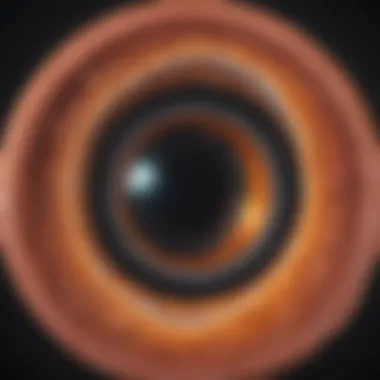Understanding Recovery Time for Macular Holes


Intro
Macular holes provide a significant challenge to vision. When they form, they create a disruption in the central part of the retina known as the macula. This can lead to blurred vision or even distortion, affecting daily activities like reading or recognizing faces. Recovery from this condition is essential for restoring visual quality.
The path to recovery varies greatly among patients. It is shaped by numerous factors including individual health conditions, age, and the type of surgical intervention performed. This article seeks to illuminate the complexities surrounding macular hole recovery, presenting what patients and healthcare providers should anticipate.
Key Concepts
Understanding the recovery process starts with familiarizing oneself with the terminology and underlying principles associated with macular holes.
Definition of Primary Terms
- Macular Hole: A small break in the macula which is crucial for sharp, central vision.
- Surgical Intervention: This refers to procedures like vitrectomy, employed to repair the hole.
- Post-operative Care: Guidelines and practices recommended after surgery to enhance recovery and minimize complications.
Related Concepts and Theories
- Recovery Timeline: Not every patient heals in the same timeframe. Factors influencing this include the size of the hole and the method of repair.
- Adherence to Post-operative Instructions: Following the doctor’s guidelines can significantly influence recovery speed. Patients must understand the necessity of follow-up appointments to monitor healing.
Recovery Factors
Several elements play a role in determining how long it takes for someone to recover from a macular hole.
- Surgical Technique: Different techniques can result in varied recovery experiences. Vitrectomy is the most common surgical option.
- Patient Demographics: Age and overall health can also affect recovery. Older patients may have slower healing rates.
- Complications: Possible issues like retinal detachment can extend recovery time.
"The efficiency of recovery is not just about the surgery; it's about how each patient responds overall to the treatment."
Future Directions
While the current understanding of macular hole recovery is extensive, recognizable gaps persist in research in this area.
Gaps Identified in Current Research
- Long-term Outcomes: More studies are needed focusing on the long-term effects of surgical procedures on visual acuity.
- Patient-Reported Outcomes: Understanding patients' perspectives post-surgery could contribute to better care practices.
Suggestions for Further Studies
- Comparative Studies: Researching different treatment methodologies could highlight more effective practices.
- Enhanced Recovery Protocols: Developing comprehensive guidelines tailored to individual patient needs may improve recovery outcomes.
By examining these aspects, we can build a more thorough understanding of what individuals may experience during their recovery from macular holes. This discussion will pave the way for further examination and research, ultimately leading to enhanced patient care.
Prologue to Macular Holes
Macular holes are critical conditions that affect the central retina, leading to significant vision impairment. Understanding the formation and implications of macular holes is essential for both patients and healthcare professionals. Awareness of this topic helps in early diagnosis and intervention, often crucial in safeguarding vision. Comprehensive knowledge can lead to better treatment outcomes and improved quality of life for affected individuals.
Definition and Anatomy
A macular hole is a small break in the macula, the part of the retina responsible for sharp, central vision. This condition typically occurs in one eye, although it can affect both. The macula is located near the center of the retina and plays an integral role in visual acuity. Its structural importance cannot be understated; it consists of layers of cells, including photoreceptors that convert light into neural signals. When a macular hole forms, it disrupts these functions, leading to blurred or distorted vision.
Epidemiology of Macular Holes
The prevalence of macular holes varies, but they are more commonly seen in individuals over the age of 60. Studies indicate that they occur in about 2% of the general population, with a higher incidence in women compared to men. Additionally, the risk factors may include conditions such as myopia and a history of eye trauma. Understanding the demographics associated with macular holes can aid in prevention and early detection efforts.
Pathophysiology of Macular Holes
Understanding the pathophysiology of macular holes is crucial for a comprehensive grasp of the condition. Macular holes primarily arise due to vitreous traction on the macula, which is the central part of the retina responsible for high-resolution vision. This section outlines the mechanisms that lead to macular hole formation and diagnosis, while focusing on implications for recovery.
Causes of Macular Hole Formation
Several factors can contribute to the formation of macular holes. Here are key aspects:
- Age-related Changes: With advancing age, the vitreous gel that fills the eye may undergo liquefaction. This change can create stress on the retina, resulting in a macular hole.
- Trauma: Physical trauma to the eye can cause direct damage leading to the development of holes. Events can range from sports injuries to accidents.
- High Myopia: Individuals with a high degree of nearsightedness often have an elongated eye shape, which increases the risk of retinal complications, including macular holes.
- Cystoid Macular Edema: Inflammatory processes in the eye, such as cystoid macular edema, can affect the retinal layers and contribute to hole formation.
- Genetic Factors: Family history or genetic predispositions may increase vulnerability to developing macular holes.
The understanding of these various causes is significant as it shapes both the clinical approach to treatment and the expectations for recovery. Knowing the potential triggers allows healthcare professionals to tailor preventive and therapeutic strategies.


Symptoms and Diagnosis
Diagnosing a macular hole relies on recognizing specific symptoms and confirming through various methods. Key symptoms include:
- Central Vision Distortion: Patients may notice a wavy or distorted central vision, often affecting reading and detailed tasks.
- Visual Field Loss: There can be progressive loss of vision in the central field.
- Difficulty in Color Perception: Changes in color perception can also be an early sign.
Diagnosis typically involves the following:
- Comprehensive Eye Exam: An ophthalmologist conducts a thorough examination, assessing visual acuity and inspecting the retina.
- Optical Coherence Tomography (OCT): This imaging technique offers cross-sectional views of the retina, helping to identify any holes or abnormalities in the macular region.
- Fluorescein Angiography: A dye is injected into the bloodstream to visualize blood flow in the retina, allowing for detailed evaluation.
Diagnosing a macular hole early is pivotal. It helps in planning timely intervention, potentially improving outcomes.
In summary, the pathophysiological aspects of macular holes reveal crucial insights into their causes and diagnostic strategies. Understanding these elements aids in aligning treatment plans and formulating better expectations for recovery.
Surgical Treatment Options
The choice of surgical treatment for macular holes represents a critical component in the overall management of this condition. Given that macular holes significantly impair central vision, choosing an effective surgical intervention can lead to considerable improvements in visual acuity and quality of life. Understanding the specific surgical procedures available, their mechanics, and post-operative care is essential for patients, healthcare providers, and researchers alike.
Vitrectomy Procedure
Vitrectomy is the most commonly employed surgical technique in the treatment of macular holes. It involves the removal of the vitreous gel, which often exerts traction on the retina, potentially aggravating the hole. By addressing this, the likelihood of successful closure increases.
During the procedure, surgeons access the eye through small incisions, using specialized instruments to gently remove the vitreous. Once this is done, surgeons carefully examine the macula for the hole. To aid in the healing process, they may employ techniques such as an internal limiting membrane peeling, which can promote cellular healing at and around the hole.
The overall success rate for vitrectomy in closing macular holes is relatively high, often exceeding 90%. However, optimal outcomes are contingent on a range of factors including the duration of the hole before surgery and the presence of other retinal conditions.
Gas Tamponade and Air
Following vitrectomy, gas tamponade is typically used to help maintain the anatomical integrity of the eye while healing occurs. A gas bubble is often introduced into the eye that applies pressure against the macula, encouraging the edges of the hole to adhere.
Depending on the specific gas used, it may be necessary for patients to maintain a particular position to ensure the gas bubble remains in contact with the macula. For example, positioning face-down is often advised for patients during the recovery period to enhance the effectiveness of the bubble.
It is crucial to understand the implications of gas tamponade. Patients should be aware of potential side effects, including transient vision changes. Furthermore, the duration that the gas bubble remains in the eye can vary, usually lasting from several days to weeks, contributing to the overall recovery timeline.
Role of Post-Operative Care
Post-operative care is paramount in optimizing recovery from macular hole surgery. It involves a series of follow-up appointments that allow healthcare providers to monitor healing progression and detect any complications early. Adherence to the recommended post-operative regimen encourages optimal healing outcomes.
Key components of post-operative care include:
- Positioning Instructions: As mentioned, maintaining specific positions can be crucial, especially in the early recovery stages.
- Medications: Patients may be prescribed topical antibiotics to minimize infection risks, as well as anti-inflammatory medications to reduce swelling.
- Visual Acuity Assessments: Regular assessments are important to track improvements in visual function and detect any issues that may arise during recovery.
"Appropriate post-operative care significantly enhances the likelihood of a successful outcome after macular hole surgery. Patients should commit to attending all follow-up appointments and adhere to their physician's guidance closely."
In summary, understanding the surgical treatment options for macular holes and their implications is critical. From the vitrectomy procedure to gas tamponade, and the essential role of post-operative care, each aspect intertwines to facilitate overall recovery and restore visual function.
Recovery Timeline After Surgery
The recovery timeline after surgery for a macular hole is critical for understanding how the healing process unfolds. This period can vary from person to person and is influenced by various factors. Tracking recovery is essential not only for patients but also for healthcare providers. Being aware of what to expect at each stage can increase compliance with post-operative care. It can also aid in identifying any complications early.
Immediate Post-Operative Phase
Following the vitrectomy procedure, the immediate post-operative phase plays a fundamental role in a patient's healing. This phase usually begins right after the procedure ends and lasts for a few days. It is during this time that the patient may experience discomfort or some degree of pain. Medications are often prescribed to manage these symptoms.
Patients should avoid any strenuous activities. Laying in a specific position may be required to allow the gas bubble to properly settle against the macular hole. Additionally, patients need to attend their follow-up appointments for monitoring. The eye care professional will check for signs of any complications, which is vital.
Key considerations during this time include:
- Pain Management: Effectively managing pain helps with overall comfort.
- Observation for Complications: Early identification of issues like retinal detachment can lead to better outcomes.
Weeks One to Six
The first six weeks post-surgery are vital for recovery. During this period, patients might notice gradual improvement in their vision, but this varies by individual. Many will start to engage in gentle activities and slowly get back to their routines.
In this phase, it’s important to follow specific post-operative instructions. The adherence to these guidelines can significantly influence the recovery rate. Patients should prioritize:


- Visual Rest: Limiting screen time and bright light exposure helps reduce strain on the eyes.
- Nutrition: Maintaining a balanced diet supports general health and can enhance healing.
- Regular Check-Ups: Frequent visits to the eye care specialist help track progress.
Long-Term Recovery Milestones
As recovery progresses beyond the six-week mark, some long-term milestones become evident. Patients may start experiencing more stable vision. This long-term phase can extend anywhere from a few months to a year, depending on individual cases.
During this time, the focus shifts towards:
- Adaptive Strategies: Learning how to adapt to visual changes for daily tasks can improve quality of life.
- Ongoing Assessments: Visual acuity tests become standard to monitor progress.
- Emotional Support: Acknowledging the emotional impact of changes in vision helps with overall well-being.
In summary, the recovery timeline after macular hole surgery is a structured process that encompasses various important phases. Engaging with healthcare professionals throughout this timeline is essential for optimizing outcomes and navigating potential complications.
Factors Influencing Recovery Time
The recovery time from a macular hole surgery is not uniform across all patients. Factors that influence this period are crucial for understanding individual healing processes. Different aspects play a role in determining how quickly a person may recover and regain sight. Factors include a person's age and overall health, the specific type of macular hole, and the surgical techniques used during the operation.
Patient Age and Health Status
Age significantly impacts recovery time for individuals who have undergone macular hole surgery. Older patients often experience longer recovery periods. This delay can be due to a variety of factors, including overall vitality and the presence of other concurrent health issues. For example, patients with underlying conditions such as diabetes or hypertension may face complications that prolong healing.
Health status also affects how well a patient responds to surgery. A robust immune system can promote quicker recovery, while those with compromised health may take longer to heal. Furthermore, compliance with post-operative guidelines directly correlates with recovery effectiveness. Therefore, health optimization before and after surgery is critical.
Type of Macular Hole
There are different types of macular holes, and each type can influence recovery experience and time. A full-thickness macular hole, for instance, usually entails longer recovery times compared to a partial thickness hole. Full-thickness holes involve more extensive retinal tissue, which requires more healing.
Moreover, the duration that the hole has been present prior to surgery also matters. Chronic macular holes that have been untreated for extended periods can result in more damage and increased recovery time. The initial condition of the eye before surgery is a significant factor in how well the patient will heal post-operation.
Surgical Technique Employed
The specific surgical technique can also sway recovery duration. The most common procedure for treating macular holes is vitrectomy, which involves the removal of the vitreous gel and may include subsequent gas tamponade to help appose the edges of the hole during healing.
Variations in this procedure, such as whether a patient had additional interventions during surgery, will impact recovery. For instance, simpler techniques with no added steps tend to lead to faster recovery times. Conversely, more complex procedures might require a longer healing period. Post-operative recommendations, such as positioning and mobility, also vary depending on the method used.
"Individual recovery experiences can differ markedly depending on age, health, type of macular hole, and surgical techniques employed."
Potential Post-Operative Complications
Post-operative complications are a significant aspect of surgery for macular holes. Understanding these complications is essential for patients and healthcare providers alike. They can impact recovery time and the overall success of the surgical intervention, making it vital to be aware of the potential risks.
Complications can arise due to various factors, including surgical technique, patient health, and post-operative care. Recognizing these factors could be beneficial in minimizing risks and preparing patients for their recovery journey. Sometimes, complications may be mild and manageable; however, in other cases, they could lead to long-term issues such as vision loss.
It is important for patients to discuss potential complications with their surgeon before the procedure.
Retinal Detachment
Retinal detachment is a rare but serious post-operative complication that can occur following macular hole repair. It happens when the retina pulls away from its supportive tissue, leading to potential permanent vision loss. This condition may arise due to the manipulation of the retinal layers during surgery or from the presence of any pre-existing weaknesses in the retina.
Symptoms of retinal detachment can include:
- Sudden appearance of floaters
- Flashes of light
- A shadow or curtain effect over the visual field
Patients who experience any of these symptoms after surgery should seek immediate medical attention. Early intervention could significantly improve outcomes. Regular follow-ups can help monitor the integrity of the retina and catch any signs of detachment promptly.
Infection Risks
Infection is another potential complication that patients must consider. Though rare due to modern surgical techniques and sterile procedures, post-operative infections can occur. Such infections typically result from bacteria infiltrating the surgical site and can lead to severe complications if not treated quickly.
Common signs of infection include:
- Increased redness around the eye
- Discharge or pus
- Pain or swelling
Proper hygiene practices and adherence to post-operative care instructions can reduce infection risks. Patients should be educated about the importance of keeping the surgical area clean, using prescribed medications correctly, and attending follow-up appointments to monitor healing.


Vision Fluctuations
Fluctuations in vision represent a common experience during recovery from macular hole surgery. These changes can be attributed to multiple factors, including the healing process of the retina, alterations in eye pressure, and the initial trauma caused by surgery. Vision may vary from blurry to clear, and patients may also experience challenges in depth perception.
It is essential for individuals to understand that fluctuations in vision do not necessarily indicate that something is wrong. However, if the changes are persistent or worsen over time, it may warrant further evaluation. Regular visual assessments post-surgery become crucial in determining the healing progress.
In summary, understanding potential post-operative complications enables patients and healthcare professionals to foster a proactive approach to recovery. Awareness of retinal detachment, infection risks, and vision fluctuations can equip individuals with the knowledge needed for better outcomes.
Monitoring Recovery Progress
Monitoring recovery progress is an essential component of post-surgical care for patients recovering from macular hole surgery. Keeping track of recovery steps helps identify any complications early, ensuring timely intervention. Engaging with healthcare professionals during this phase supports the physical healing process while providing mental reassurance to patients.
Importance of Follow-Up Appointments
Follow-up appointments serve a dual purpose; they are crucial for assessing healing and for psychological support. During these visits, eye specialists evaluate the surgical site and monitor any changes in vision. These appointments offer patients a structured timeline to track advancements in their recovery.
Regular follow-ups can help detect potential complications early. Notably, signs such as retinal detachment or unusual vision changes can be alarming. Early identification of these issues allows for prompt corrective measures, which can be vital in preventing further vision loss.
Patients should consider the following benefits of attending scheduled follow-ups:
- Assessing Doctor's Feedback: Hearing a healthcare professional affirm that healing is on track can provide reassurance.
- Vision Improvement Tracking: Keeping records of visual acuity can show progress over time.
- Adjustments in Treatment Plans: Having ongoing assessments can lead to alterations in post-operative care if deemed necessary.
By maintaining consistent communication with their medical team, patients can personalize their recovery plans better, increasing their chances of successful outcomes.
Visual Acuity Assessments
Visual acuity assessments are a key part of the follow-up process after macular hole surgery. These evaluations measure how well patients can see at various distances, which is crucial for determining the effectiveness of the surgical intervention. They provide quantitative data on how much vision has improved or whether any complications have developed.
Typically, these assessments involve standard vision tests, which are straightforward and non-invasive. These might include the Snellen chart test or specialized imaging techniques to evaluate retinal structure. The information gathered can play a significant role in understanding recovery status.
For patients, improved visual acuity is often a primary goal. Patients may find it encouraging to see measurable proof of progress, fostering a positive outlook on their recovery journey. Regular assessments allow for:
- Objective Analysis: Clinicians can gauge the success of the surgery quantitatively.
- Informed Discussions: Patients are better equipped to understand their condition and make decisions about further care or interventions.
- Long-term Monitoring: Establishing a baseline helps in tracking declines or improvements in vision over time.
"Monitoring recovery through regular follow-up and visual acuity assessments can make a significant difference in overall outcomes and patient satisfaction."
Thus, patients and clinicians alike should prioritize regular assessments to ensure a smooth recovery path.
Psychosocial Considerations
Psychosocial factors play a critical role in the recovery process from macular hole surgery. Individuals undergoing these procedures often experience emotional and psychological challenges. This can include anxiety related to vision loss, fear of post-operative complications, and frustration with limitations in daily life. Understanding these aspects is essential for both patients and healthcare providers to ensure a comprehensive approach to recovery.
Impact on Daily Life
The impact of a macular hole on daily activities is significant. Patients may have difficulty with tasks such as reading, driving, or recognizing faces. This can lead to social isolation and a decline in quality of life. Furthermore, changes in vision may demand adjustments in living arrangements, hobbies, and professional roles. The emotional toll can manifest as stress or depression, further complicating the recovery process. Therefore, addressing these daily challenges is paramount.
Support Systems and Resources
Access to support systems can greatly enhance recovery during this period. Family members, friends, and support groups provide crucial emotional backing, but professional resources are equally important. Counseling and psychological support can help manage feelings of anxiety and frustration. Eye care professionals may also offer insights into organizations and online communities focused on macular health, which can connect patients with similar experiences. Leveraging these resources can foster a sense of community and shared understanding, aiding in the emotional and psychological recovery process.
"Psychosocial well-being is as vital as physical recovery. Patients benefit from addressing both sides of their healing journey."
In summary, recognizing the psychosocial facets of recovery enhances the overall treatment experience for those with macular holes. By prioritizing both emotional support and practical resources, patients can navigate their recovery journey with a greater sense of empowerment and resilience.
Epilogue and Future Directions
Understanding the recovery time from a macular hole is crucial for patients navigating their post-operative journey. This section highlights the significant elements related to recovery, including expectations, the role of medical interventions, and the necessity of a supportive environment throughout the healing process. It is vital for individuals to be aware of how various factors can shape their recovery timelines. Knowledge empowers patients to participate actively in their healing, fostering a positive mindset and adherence to care guidelines.
Summary of Key Points
In summarizing the pivotal takeaways from the article, the focus remains on:
- Recovery Phases: Recovery occurs in distinct phases, starting with the immediate post-operative period and extending to long-term recovery milestones.
- Influencing Factors: Patient characteristics, including age, general health status, and specific macular hole types, significantly impact recovery durations.
- Post-Operative Care: Active management of follow-up appointments and adherence to prescribed therapies is essential for optimal visual outcomes.
- Complexity of Healing: Not all patients experience recovery in the same manner. Variability in healing responses should be anticipated, and patience is necessary.
Research Opportunities
The field of retinal health continues to evolve, presenting numerous avenues for future research. Potential areas include:
- Longitudinal Studies: Investigating long-term recovery patterns can provide insights into the durability of surgical results and the evolution of patient outcomes over time.
- Comparative Analyses: Evaluating different surgical techniques and their impact on recovery can assist in refining treatment protocols and improving patient experiences.
- Patient Demographics: Research focused on how demographic factors such as ethnicity, gender, and lifestyle habits influence healing may yield valuable information for personalized treatment approaches.
- Technological Advances: Innovations in imaging and surgical techniques warrant exploration to evaluate how they can enhance recovery and vision restoration.
The complexity of macular hole recovery is as varied as the individuals affected. Further research can illuminate the path forward for patients seeking improved outcomes.



